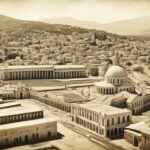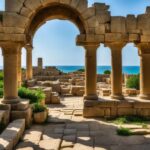Caesarea is a city of immense biblical significance, mentioned in the New Testament and revered for its historical and cultural heritage. Located in northern Israel, Caesarea holds a pivotal place in biblical history. It was the site where Jesus revealed his identity as the Jewish Messiah, an event etched in the pages of the New Testament.
The city of Caesarea was once known as Caesarea Philippi, or ancient Paneas. It was a vibrant and lush city, overlooking the Jordan River Valley and surrounded by the grandeur of Mount Hermon. In biblical times, it played host to a potent blend of pagan religious practices and Jewish traditions.
Key Takeaways:
- Caesarea is a city of immense biblical significance, mentioned in the New Testament.
- It was the site where Jesus revealed his identity as the Jewish Messiah.
- Caesarea was once known as Caesarea Philippi and had a rich history of pagan worship.
- The city’s location offered breathtaking views of the Jordan River Valley.
- Caesarea holds a pivotal place in biblical history and our understanding of early Christianity.
Historical Significance of Caesarea Philippi
Caesarea Philippi, also known as ancient Paneas, holds historical significance in the New Testament. It was the site where Jesus revealed his identity as the Jewish Messiah to his disciples.
The city had a sanctuary to Baal built by the ancient Canaanites, and later sanctuaries were constructed by the Greeks and Romans due to the cave of Pan. This location was also associated with idolatry and pagan worship.
The historical context of Caesarea Philippi is crucial to understanding the events that took place there during Jesus’ ministry. It provides valuable insights into the cultural and religious practices of the time.
Geographical Location of Caesarea Philippi
In the northern region of Israel lies the captivating city of Caesarea Philippi. Positioned approximately 30 miles beyond the scenic Sea of Galilee, this ancient city sits on a picturesque terrace at the foot of Mount Hermon, reaching an elevation of around 1150 feet above sea level. From this vantage point, visitors are treated to a breathtaking panoramic view of the Jordan River Valley, a testament to the city’s remarkable geographic location.
Caesarea Philippi is conveniently nestled near the city of Dan, which adds to its historical significance and cultural connections. Moreover, the city served as a vital hub for trade routes linking Phoenician ports and the bustling city of Damascus. Its strategic placement in the northern reaches of Israel made Caesarea Philippi an important center of commerce and a gateway to the wider region.
Explore the geographical splendor of Caesarea Philippi as you immerse yourself in its captivating history and discover the wonders of the Jordan River Valley.

“In the northern region of Israel lies the captivating city of Caesarea Philippi.”
Key Points:
- Caesarea Philippi is located in northern Israel, approximately 30 miles past the Sea of Galilee.
- Situated on a terrace at the foot of Mount Hermon, the city offers a majestic view of the upper Jordan River Valley.
- The city is positioned near the city of Dan and served as a critical trade hub for Phoenician ports and Damascus.
Archaeological Discoveries in Caesarea Philippi
Caesarea Philippi is an archaeological site that offers fascinating insights into the rich history and culture of this ancient city. Through extensive excavations, researchers have uncovered the remains of various sanctuaries, shedding light on the religious practices of the time. Among the notable discoveries are the ruins of the temple of Augustus, the temple of Zeus, and the temple of Pan.
These structures provide a glimpse into the diverse religious beliefs and worship that took place in Caesarea Philippi. They stand as a testament to the city’s significant role in ancient society and offer valuable clues about the religious landscape of the region.
Furthermore, the archaeological site has revealed evidence of the famous cave of Pan, a natural grotto that held great importance in ancient pagan worship. Its discovery adds another layer of understanding to the religious practices and rituals that took place in Caesarea Philippi.
Additionally, the excavation has brought to light the water source that fed the Jordan River. This finding contributes to our understanding of the city’s geographical and hydrological significance, as well as its role in sustaining life in the region.
“The archaeological discoveries in Caesarea Philippi provide us with tangible evidence of the city’s ancient past. They allow us to piece together the story of this remarkable place and gain a deeper understanding of its significance in biblical times.”
Theological Themes in Caesarea Philippi
Caesarea Philippi holds significant theological implications in the New Testament. Situated in northern Israel, the city was associated with pagan worship and idolatry, including the worship of Baal and the god Pan. Jesus deliberately chose this particular location to reveal his identity as the Messiah, which carries symbolic meaning.
Caesarea Philippi served as a backdrop where pagan beliefs intertwined with Jewish traditions, highlighting the clash between the Roman influence and the ancient faith. This amalgamation of cultures and religions provides insight into the cultural and religious practices of the time.
In this city, the theological themes reveal the complex dynamics between Roman influence, pagan worship, and the emergence of Christianity. It symbolizes a pivotal moment where Jesus establishes his authority over conflicting beliefs and ushers in a new era.
“Upon this rock, I will build my church, and the gates of Hades shall not prevail against it.” – Matthew 16:18
This statement by Jesus emphasizes the triumph of his church over the powers of darkness. It signifies that the spread of Christianity would prevail against the prevailing pagan practices and beliefs present in Caesarea Philippi.
The theological significance of Caesarea Philippi serves as a reminder of the cultural and religious context in which Jesus revealed himself as the Messiah, and the subsequent impact it had on the development of Christianity.
Religious Practices in Caesarea Philippi
In Caesarea Philippi, religious practices were diverse and carried out within the context of multiple deities. The city featured sanctuaries dedicated to various gods, including the prominent worship of Baal and the god Pan.
The worship of Baal originated with the Canaanites and continued with the influence of Greek and Roman cultures. Additionally, the presence of the cave of Pan contributed to the religious practices associated with this deity.
“…Who do people say that the Son of Man is?” They replied, “Some say John the Baptist; others say Elijah; and still others, Jeremiah or one of the prophets.” – Matthew 16:13-14
This conversation between Jesus and his disciples reflects the diverse beliefs prevalent in Caesarea Philippi. The religious practices of the city were deeply embedded in the culture and played a significant role in shaping the theological themes present in the New Testament.
Pagan Worship and Influence
Caesarea Philippi was characterized by its association with pagan worship and idolatry. The city’s pagan sanctuaries, including the cave dedicated to Pan, attracted worshipers from various regions.
The cave of Pan was believed to be the gateway to the underworld, and the lush landscape surrounding the area added to its mystique. These pagan practices represented a challenge to the teachings of Jesus and the spread of Christianity in the region.
However, Jesus’ choice to reveal himself as the Messiah in this city reinforced the message of redemption and victory over pagan influences. The theological themes present in Caesarea Philippi highlight the clash between conflicting beliefs and the ultimate triumph of Christianity.
Key Biblical Events in Caesarea Philippi
Caesarea Philippi witnessed two key events that hold immense biblical significance. Firstly, it was the place where Jesus chose to reveal his true identity to his disciples, declaring himself as the Messiah. This pivotal moment is detailed in Matthew 16:15-16:
“But what about you?” he asked. “Who do you say I am?” Simon Peter answered, “You are the Messiah, the Son of the living God.”
This revelation marked a turning point in Jesus’ ministry and laid the foundation for the establishment of the church.
Secondly, Caesarea Philippi is where Peter made his profound confession of faith in Jesus. In Matthew 16:16, Peter declares:
“You are the Christ, the Son of the living God.”
This confession affirmed Peter’s recognition of Jesus as the long-awaited Messiah, solidifying his role as a foundational figure in the early Christian community.
These events in Caesarea Philippi played a crucial role in shaping the narrative of the New Testament and had a profound impact on the development of Christianity as a global faith.

Cultural and Religious Practices in Caesarea Philippi
Caesarea Philippi was a city with a vibrant and diverse cultural landscape that encompassed various religious practices. The population of the city consisted of both Gentiles and Jews, leading to occasional disputes and tensions within the community.
One of the striking features of Caesarea Philippi was the presence of sanctuaries dedicated to different gods, offering a glimpse into the religious beliefs and practices of the time. The city boasted sanctuaries to Baal and the cave of Pan, which held significant importance in ancient pagan worship.
The blend of diverse cultural influences and religious practices in Caesarea Philippi provides valuable insight into the social dynamics and belief systems of the people living in the ancient city.
| Religious Practices | Cultural Dynamics |
|---|---|
| The worship of Baal | Gentiles and Jews coexisting |
| Cave of Pan ceremonies | Occasional disputes and tensions |
| Diverse pagan rituals | Blending of different cultural influences |
The cultural and religious practices in Caesarea Philippi reflect the complex tapestry of beliefs and values that shaped the society of the ancient city. Understanding these practices provides valuable insights into the historical context of Caesarea Philippi and its significance in biblical times.
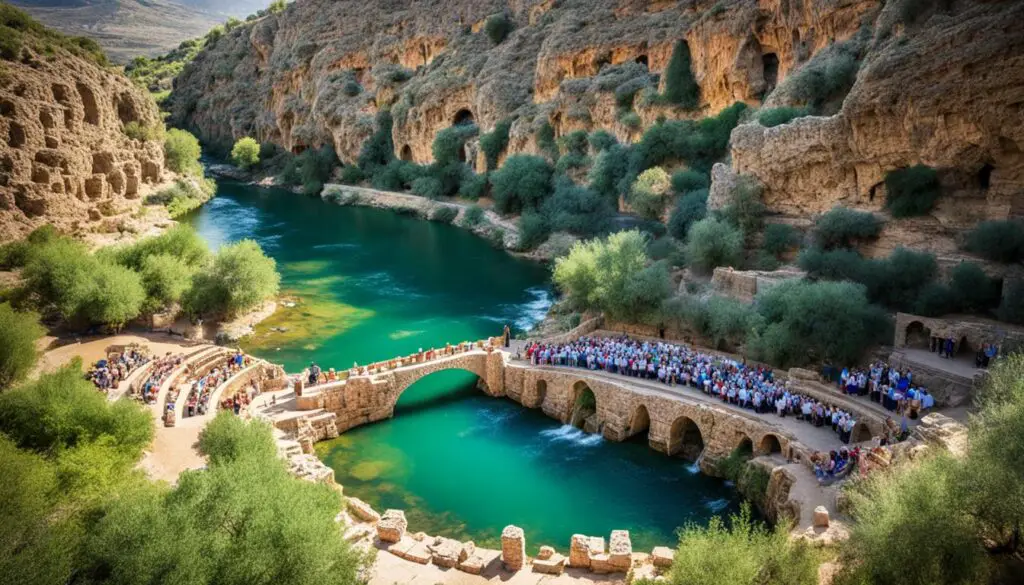
Prophetic and Eschatological Significance of Caesarea Philippi
Caesarea Philippi holds profound prophetic and eschatological significance within the New Testament. Situated amidst pagan worship and idolatry, this location symbolizes the gates of Hades or the realm of the dead. When Jesus chose to reveal his identity as the Messiah in this place, it carried a powerful message of victory over death and the powers of darkness. This pivotal event foreshadows the establishment and ultimate triumph of the church, signifying its ability to overcome the forces of evil.
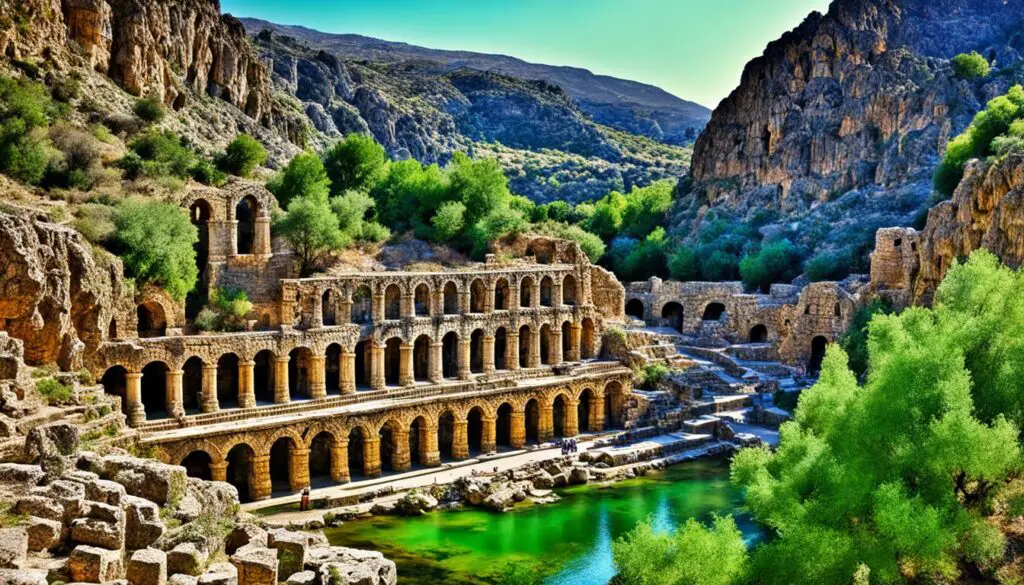
Caesarea Philippi plays a pivotal role in the eschatological narrative, representing the divine plan for the future. It serves as a significant backdrop for the unfolding of God’s ultimate purposes and highlights the spiritual battles that will be fought and won. The choice of this location underscores the decisive victory that Jesus will ultimately achieve over the powers of darkness and evil. It symbolizes the ultimate fulfillment of God’s plan for redemption and the establishment of his kingdom.
“And I tell you that you are Peter, and on this rock I will build my church, and the gates of Hades will not overcome it.” – Matthew 16:18
The proclamation of Peter’s confession at Caesarea Philippi holds a profound eschatological significance. It represents the foundation upon which the church will be built, even in the face of great opposition and the powers of darkness. This declaration foreshadows the triumph of the church in the eschatological age, where the gates of Hades will be powerless to prevail against it.
The prophetic and eschatological significance of Caesarea Philippi highlights the overarching theme of victory over death and the establishment of God’s kingdom. By understanding the historical and biblical context of this pivotal location, we gain deeper insights into the spiritual battles that were fought and the ultimate triumph that awaits believers in Christ.
Caesarea in Ancient Times: Roman Influence
Under Roman rule, Caesarea experienced significant transformations that shaped its architecture and historical significance. As a Roman client king, Herod the Great played a pivotal role in developing the city into a grand metropolis.
Herod’s vision for Caesarea included the construction of a deep sea harbor, an aqueduct, a hippodrome, and an amphitheater, showcasing the advanced engineering and architectural prowess of the Romans. These structures not only served practical purposes but also symbolized Roman power and influence in the region.
The strategic location of Caesarea made it an important center of Roman influence in the Eastern Mediterranean. It became the capital of Roman and Byzantine Palestine, attracting administrators, merchants, and artists from all over the empire. The Roman presence in Caesarea influenced various aspects of the city’s culture, society, and governance.
One of the most remarkable features of Caesarea’s Roman influence is its architectural legacy. The city’s structures, influenced by Roman engineering and design, incorporated elements such as arches, columns, and ornate decorations. These architectural marvels represented the grandeur and opulence of Roman culture.
Furthermore, the Roman influence in Caesarea extended beyond architecture. The Roman legal system, governance practices, and social customs became integral parts of the city’s daily life. The Roman presence also introduced new industries and trading opportunities, contributing to the prosperity and economic growth of Caesarea.
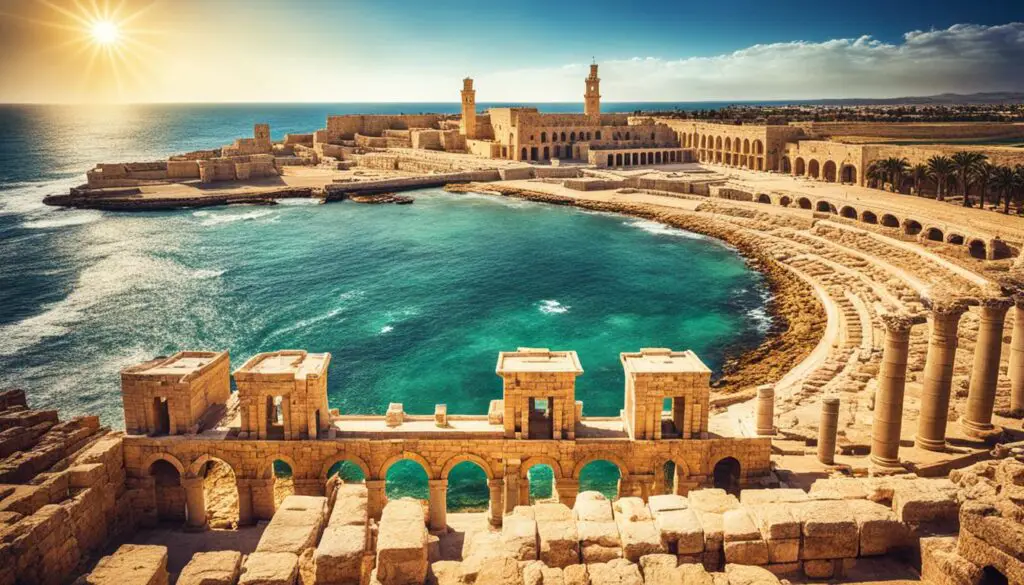
Features of Roman Influence in Caesarea:
| Architecture | Governance | Commerce |
|---|---|---|
| • Grand structures, such as the amphitheater and hippodrome. | • Adopted Roman legal system and governance practices. | • Thriving trade routes and economic growth. |
| • Arches, columns, and ornate decorations. | • Roman administrators and bureaucrats. | • Introduction of new industries. |
| • Symbolized Roman power and influence. | • Incorporation of Roman social customs. | • Increased cultural exchange. |
The Roman influence in Caesarea is testament to the city’s importance in ancient times. It not only shaped the physical landscape but also had a profound impact on the cultural, economic, and social fabric of the region. The remnants of Roman influence in Caesarea continue to stand as a testament to the city’s rich history and its significance in the Roman Empire.
Conclusion
Caesarea in the Bible is a location of immense historical, geographical, and theological significance. This ancient city, situated in northern Israel, played a pivotal role in the life of Jesus and the establishment of the Christian faith. It was in Caesarea that Jesus revealed his identity as the Messiah, and Peter acknowledged him as the Son of the living God.
The archaeological remains in Caesarea provide a window into the cultural and religious practices of the time, offering valuable insights into the ancient world. The proximity of Caesarea to other important biblical sites, such as Dan, further underscores its significance in biblical history.
By understanding the context and significance of Caesarea in the Bible, we deepen our knowledge and appreciation of the roots of Christianity. As we explore the ancient ruins, encounter the stories of Jesus and his disciples, and unravel the theological themes, we gain a greater understanding of the faith that has shaped countless lives for centuries.


